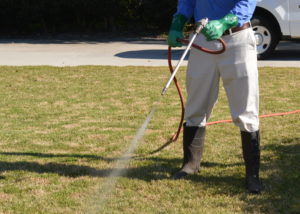To many folks, having a lush green, soft lawn for the pets and kids to play on is an important part of their landscape and even their home. Keeping it healthy, weed-free, well-watered, and rich with nutrients is essential to having a great lawn to show off to the world. Where quite a few homeowners fall short, is fertilizing care and treatments. Wrong application and timing of fertilizer could be what’s making the grass appear patchy and off. We at Rentokil would like to take the time in giving you tips on fertilizing your lawn.
Annual Lawn Feeding Program & Quarterly Fertilization Schedule
A healthy root system to your lawn can help resist intense heat, cold, droughts as well as the abuse of mowing, foot traffic, and other forms. To best get your lawn’s root healthy and strengthened is to feed it. Annual feeding is a well-practiced habit in caring for your lawn, but performing the fertilization maintenance four times a year is optimal for achieving a healthy, green, and lush lawn.
Best Time to Fertilize Lawn; After Winter, Spring, Summer & Fall Seasons
– Early Spring Lawn Fertilizer: Late February to early April is perfect for the lawn’s breakfast. Lawns that are dormant in the winter wake in early spring needing nutrients to get energized. The spring fertilization will give the roots an early jump on strengthening just before the intense growing season commences. The first time your lawn needs mowing is an excellent guideline as to when the first of the year’s fertilizing treatment should be done.
– Late Spring Lawn Fertilizer: Late April through early June is the next fertilizing treatment. The stored energy is nearly depleted about this time and the lawn is looking for sustenance. Supplying some well-earned feeding is fitting for this task. This is the time of year where the broadleaf weeds are active. In your fertilizing treatment, combine it with an appropriate weed control aid.
– Summer Lawn Fertilizer: The third treatment is ideal through late June and mid-September. Though summers are encouraging your grass to grow, it is also taking additional abuse from insect activity, additional foot traffic, heat, and in some circumstances drought conditions. Fertilizing the lawn in the summer can offer it additional strength and protection as it takes on the added stress. Excessive insect activity in your grass should also be treated.
– Fall Lawn Fertilizer: Lastly, from Late September to mid-November the final lawn fertilization treatment should be given. With cool nights and warm days, sufficient rain, and even morning dew; fall is actually the best time of year grass can grow. To recover from the intense summer wear, the lawn is looking for more nutrients to regain its strength and get rejuvenated and revitalized. Many experts agree that fall is the most important fertilizing treatment. Just before falling into winter dormancy, apply your fertilizer to help it absorb and store the energy it needs. Roots will strengthen and their nitrogen levels will be increased and come the spring your lawn will continue to thrive.
Lawn Fertilization Services
Rentokil experts can properly treat your lawn and take on the burden you do not have time for. With our regular lawn fertilizing treatments, weed control, and insect control services, we can ensure you have a healthy-looking lawn all year long. Call us today to get started!
Need Help with Lawn Fertilization?
Annual Lawn Feeding Program & Seasonal Fertilization Schedule Tips in Garden City, UT in Salt Lake County and Northern Utah
Serving Northern Utah and Southern Idaho since 1999

